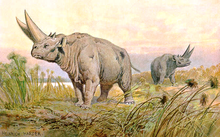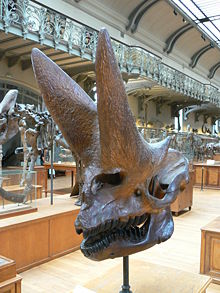Arsinoitheriidae
| Arsinoitheriids Temporal range: Middle Eocene - Early Oligocene
| |
|---|---|

| |
| Arsinoitherium zitteli | |
| Scientific classification | |
| Kingdom: | |
| Phylum: | |
| Class: | |
| Superorder: | |
| Order: | |
| Family: | †Arsinoitheriidae Andrews, 1904
|
| Genus | |
Arsinoitheriidae is a family of extinct hoofed mammals belonging to the extinct order Embrithopoda. Remains have been found in the Middle East, Africa, Asia and Romania. When alive, they would have had a great, albeit very superficial, resemblance to the modern rhinoceros. Despite this, they were not closely related to rhinoceri (or any other perissodactyl), instead being more related to hyraxes, elephants, sirenians, and possibly desmostylians.
Fossil record


Arsinoitheres first appeared in the fossil record during the Middle Eocene, with the teeth of the primitive Palaeoamasia found in Turkey.[1] The last genus is Arsinoitherium, itself, being first found in the Latest Eocene of the Fayum, then disappearing from the fossil record altogether before the end of the Early Oligocene. Crivadiatherium is known from some teeth found in the Romanian province of Transylvania in the same Late Eocene deposits where the western-most brontothere, Brachydiastematherium was found.
Etymology
The name honors the wife of Ptolemy II, Queen Arsinoe II of Egypt, as the first fossils of Arsinoitherium were found near the ruins of her palace.
References
- ^ Rose, Kenneth D. & Archibald, J. D.: The Rise of Placental Mammals (p. 266). JHU Press, 2005 ISBN 0-8018-8472-1
